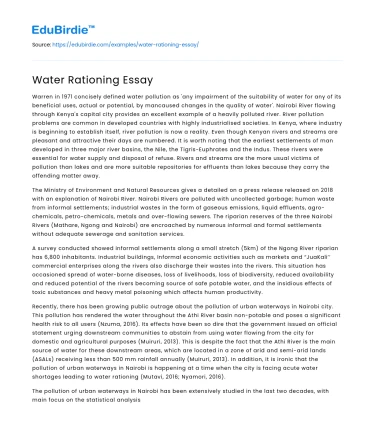Warren in 1971 concisely defined water pollution as 'any impairment of the suitability of water for any of its beneficial uses, actual or potential, by mancaused changes in the quality of water'. Nairobi River flowing through Kenya's capital city provides an excellent example of a heavily polluted river. River pollution problems are common in developed countries with highly industrialised societies. In Kenya, where industry is beginning to establish itself, river pollution is now a reality. Even though Kenyan rivers and streams are pleasant and attractive their days are numbered. It is worth noting that the earliest settlements of man developed in three major river basins, the Nile, the Tigris-Euphrates and the Indus. These rivers were essential for water supply and disposal of refuse. Rivers and streams are the more usual victims of pollution than lakes and are more suitable repositories for effluents than lakes because they carry the offending matter away.
The Ministry of Environment and Natural Resources gives a detailed on a press release released on 2018 with an explanation of Nairobi River. Nairobi Rivers are polluted with uncollected garbage; human waste from informal settlements; industrial wastes in the form of gaseous emissions, liquid effluents, agro-chemicals, petro-chemicals, metals and over-flowing sewers. The riparian reserves of the three Nairobi Rivers (Mathare, Ngong and Nairobi) are encroached by numerous informal and formal settlements without adequate sewerage and sanitation services.
Save your time!
We can take care of your essay
- Proper editing and formatting
- Free revision, title page, and bibliography
- Flexible prices and money-back guarantee
A survey conducted showed informal settlements along a small stretch (5km) of the Ngong River riparian has 6,800 inhabitants. Industrial buildings, Informal economic activities such as markets and “JuaKali’’ commercial enterprises along the rivers also discharge their wastes into the rivers. This situation has occasioned spread of water-borne diseases, loss of livelihoods, loss of biodiversity, reduced availability and reduced potential of the rivers becoming source of safe potable water, and the insidious effects of toxic substances and heavy metal poisoning which affects human productivity.
Recently, there has been growing public outrage about the pollution of urban waterways in Nairobi city. This pollution has rendered the water throughout the Athi River basin non-potable and poses a significant health risk to all users (Nzuma, 2016). Its effects have been so dire that the government issued an official statement urging downstream communities to abstain from using water flowing from the city for domestic and agricultural purposes (Muiruri, 2013). This is despite the fact that the Athi River is the main source of water for these downstream areas, which are located in a zone of arid and semi-arid lands (ASALs) receiving less than 500 mm rainfall annually (Muiruri, 2013). In addition, it is ironic that the pollution of urban waterways in Nairobi is happening at a time when the city is facing acute water shortages leading to water rationing (Mutavi, 2016; Nyamori, 2016).
The pollution of urban waterways in Nairobi has been extensively studied in the last two decades, with main focus on the statistical analysis of pollutants and on the effects of adjoining urban land uses on water quality. Water monitoring data collected within the Nairobi River Basin has indicated high pollution levels from sewage and industrial effluent (Musyoki, Suleiman, Mbithi, & Maingi, 2013). However, these monitoring exercises have not been backed up with effective remedial measures to reduce pollution, as evidenced by the current degraded state of urban waterways in Nairobi as reported by Nzuma (2016) and others.
The Nairobi River Basin Programme (NRBP) is a multi-stakeholder initiative that brings together the Government of Kenya, development partners, the private sector and civil society. The Programme is supervised by the Office of the Prime Minister, while the Ministry of Environment and Mineral Resources provides leadership and coordination of a series of start-up and program development activities involving seventeen key Government ministries and agencies. The main objective of the Programme is to rehabilitate, restore and sustainably manage the Nairobi River Basin in order to provide improved livelihoods, enhance environmental quality and values through well regulated economic and recreational ventures.






 Stuck on your essay?
Stuck on your essay?

